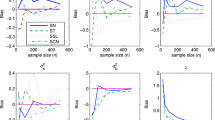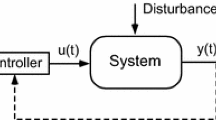Abstract
Indirect response (IDR) models are probably the most frequently applied tools relating the effect of a signal to a baseline response. A response modeled by such a classical IDR model will always return monotonously to its baseline after drug administration. We extend IDR models with a delay process, i.e. a retarded response state, that leads to oscillating response behavior. First, IDR models with a first-order production and second-order loss term based on the famous logistic equation are constructed. Second, a delay process similar to the delayed logistic equation is included. Relations of the classical IDR model with our extended IDR model concerning response and model parameters are revealed. Simulations of typical response profiles are presented and data fitting of a model for leptin and cholesterol dynamics after administration of methylprednisolone is performed. The influence of the delay parameter on the other model parameters is discussed.



Similar content being viewed by others
References
Dayneka NL, Garg V, Jusko WJ (1993) Comparison of four basic models of indirect pharmacodynamic responses. J Pharmacokinet Biopharm 21(4):457–78
Koch G, Schropp J (2013) Mathematical concepts in pharmacokinetics and pharmacodynamics with application to tumor growth. In: Kloeden PE, Poetzsche C (eds) Nonautonomous dynamical systems in the life sciences. Springer, Berlin
Sharma A, Ebling WF, Jusko WJ (1998) Precursor-dependent indirect pharmacodynamic response model for tolerance and rebound phenomena. J Pharm Sci 87(12):1577–84
Gabrielsson J, Peletier LA (2007) A nonlinear feedback model capturing different patterns of tolerance and rebound. Eur J Pharm Sci 32(2):85–104
Zuideveld KP, Maas J, Treijtel N, Hulshof J, van der Graaf PH, Peletier LA, Danhof M (2001) A set-point model with oscillatory behavior predicts the time course of 8-OH-DPAT-induced hypothermia. Am J Physiol Regulatory Integr Comp Physiol 281:R2059–R2071
Zhang Y, D’Argenio DZ (2016) Feedback control indirect response models. J Pharmacokinet Pharmacodyn 43(4):343–58
Chakraborty A, Krzyzanski W, Jusko WJ (1999) Mathematical modeling of circadian cortisol concentrations using indirect response models: comparison of several methods. J Pharmacokinet Biopharm 27(1):23–43
Verotta D (2010) Fractional dynamics pharmacokinetics-pharmacodynamic models. J Pharmacokinet Pharmacodyn 37(3):257–76
Liz E (2014) Delayed logistic population models revisited. Publ Mat 2014:309–31
Hadeler KP, Bocharov G (2003) Where to put delays in population models, in particular in the neutral case. Can Appl Math Q 11:159–73
Krzyzanski W, Ramakrishan R, Jusko WJ (1999) Basic pharmacodynamic models for agents that alter production of natural cells. J Pharmacokinet Biopharm 27:467–89
Krzyzanski W, Perez-Ruixo JJ (2012) Lifespan based indirect response models. J Pharmacokinet Pharmacodyn 39:109–23
Krzyzanski W, Jusko WJ, Wacholtz MC, Minton N, Cheung WK (2005) Pharmacokinetic and pharmacodynamic modeling of recombinant human erythropoietin after multiple subcutaneous doses in healthy subjects. Eur J Pharm Sci 26:295–306
Perez-Ruixo JJ, Krzyzanski W, Bouman-Thio E, Miller B, Jang H, Bai SA, Zhou H, Yohrling J, Cohen A, Burggraaf J, Franson K, Davis HM (2009) Pharmacokinetics and pharmacodynamics of the erythropoietin Mimetibody construct CNTO 528 in healthy subjects. Clin Pharmacokinet 48:601–13
Verhulst PF (1838) Notice sur la loi que la population suit dans son accroissement. Correspondance mathématique et physique 10:113–21
Hutchinson GE (1948) Circular causal systems in ecology. Ann New York Acad Sci 50:221–46
Smith H (2010) An introduction to delay differential equations with applications to the life sciences. Texts in Applied Mathematics. Springer, Berlin
Koch G, Krzyzanski W, Perez-Ruixo JJ, Schropp J (2014) Modeling of delays in PKPD: classical approaches and a tutorial for delay differential equations. J Pharmacokinet Pharmacodyn 41(4):291–318
Arino J, Wang L, Wolkowicz GSK (2006) An alternative formulation for a delayed logistic equation. J Theor Biol 241:109–19
Sukumaran S, Jusko WJ, DuBois DC, Almon RR (2011) Mechanistic modeling of the effects of glucocorticoids and circadian rhythms on adipokine expression. J Pharmacol Exp Ther 337(3):734–46
Hazra A, Pyszczynski NA, DuBois DC, Almon RR, Jusko WJ (2008) Modeling of corticosteroid effects on hepatic low-density lipoprotein receptors and plasma lipid dynamics in rats. Pharm Res 25(4):769–80
Hairer E, Nørsett SP, Wanner G (1993) Solving ordinary differential equations I. Springer Series in Computational Mathematics, vol 8, 2nd edn. Springer, New York
Author information
Authors and Affiliations
Corresponding author
Appendices
Appendix 1: Computation of the PD effect \(PD_{eff}\)
We have introduced the classical IDR model and the logistic equation based LoIDR and DLoIDR models. Depending on the action of the drug we have four different realizations \(f=f_i\), \(i=I,II,III,IV\) for each model. We now show the proposed PD effect \(PD_{eff}\) for these models only when the drug inhibits the inflow term, i.e., \(f=f_{I}\). A slightly modified proof also works for the three other realizations. In case of \(f=f_{I}\) we have to calculate
with \(R_{Base}=R^0\) for the classical IDR model and \(R_{Base}=R^0_L\) in case of the LoIDR and DLoIDR model.
-
(i)
IDR model PD effect:
Using Eq. (11) we obtain
Due to \(R^0 = R(0) = \lim _{t \rightarrow \infty } R(t)\) the left integral on the right hand side of Eq. (19) vanishes and we end up with
-
(ii)
LoIDR model PD effect:
With the model Eq. (14) we can calculate
Again, using \(R^0_L = R(0) = \lim _{t \rightarrow \infty } R(t)\) the first term on the right hand side of Eq. (22) vanishes and we end up with the proposed result Eq. (20).
-
(iii)
DLoIDR model PD effect:
In presence of a delay we use the initial condition \(R(s) =R^0_L\), \( -T \le s \le 0\) and rewrite the PD effect term to
We use the representation Eq. (23) of the PD effect as well as Eq. (16) and compute
The Eq. (24) and Eq. (21) are identical and we can mimic the computation of part (ii) and obtain the final result Eq. (20).
Appendix 2: Stability of the equilibria \(R^0\) and \(R^0_L\)
The base equations (\(c=0\)) to the proposed models read
for Eqs. (14)–(15) (\(T=0\)) and Eqs. (16)–(17) (\(T>0\)).
Linearizing Eqs. (25)–(26) at their baseline \(R^0\), \(R^0_L\) respectively, leads to
for the IDR model, and
for the LoIDR (\(T =0\)) and the DLoIDR Eqs. (\(T >0\)). Thus, the equilibria \(R^0\), \(R^0_L\) are stable for the IDR and the LoIDR model. Moreover, due to Hairer et al. [22] the baseline \(R^0_L\) is stable for the DLoIDR model if \(0< T < \pi /(2 k_{inL})\). Finally, comparing Eq. (27) with Eq. (28) (\(T=0\)) shows that the solutions R(t) of the classical IDR and the LoIDR model approximate the equilibria with the same exponential rate, if \(R^0 =R^0_L\) and \(k_{out} = k_{inL}\) holds.
Appendix 3: Linearized LoIDR model
Linearizing the LoIDR model Eq. (14) of type I, III at its baseline \(\bar{R} = R_L^0 = k_{inL}/k_{outL}\), \(\bar{c} = 0\) yields
which is the IDR model at \(\bar{c} =0\) with production rate \(k_{in} = k_{inL} R^0_L\) and loss rate \(k_{out}= k_{inL}\). Finally, a similar argument holds for type II, IV.
Rights and permissions
About this article
Cite this article
Koch, G., Schropp, J. Delayed logistic indirect response models: realization of oscillating behavior. J Pharmacokinet Pharmacodyn 45, 49–58 (2018). https://doi.org/10.1007/s10928-017-9563-8
Received:
Accepted:
Published:
Issue Date:
DOI: https://doi.org/10.1007/s10928-017-9563-8




